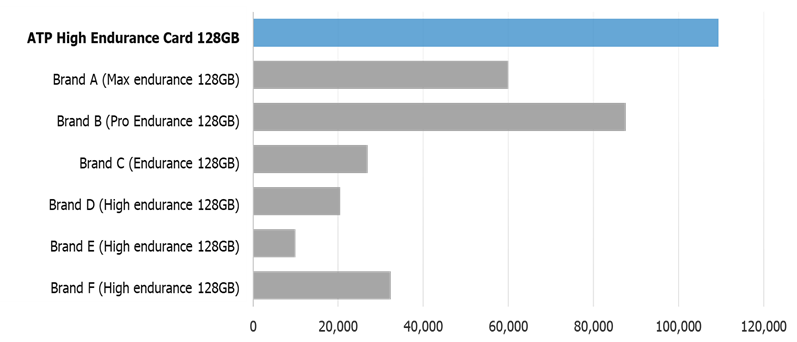A sneak peek into this edition:
- Common dashcam recording challenges
- Why constant recording causes NAND flash cells to wear out
- Why “high capacity” is not enough for non-stop recording
- Why endurance, latency, and workload are important considerations
As the resolution and development of dashcam or DVR evolve, merely looking for high-capacity storage is not enough. To record videos non-stop for thousands of hours without compromising data integrity, you will need high-endurance memory cards.

Challenges for dashcam storage
Recording Challenges
- Non-Stop Operation. Dashcams/DVRs typically operate for extended periods of time. Recording over and over again may cause NAND storage failure on video.
- Latency Under Different Temperature Profiles. Both extreme heat and cold environment can affect flash memory cells and the performance of the storage media.
- Harsh Operating Conditions. Environmental conditions of camera location contribute to flash degradation and can endanger the integrity of the data in it.
- Power Supply Instability. Any power flux or interruption may cause damage to the dashcam or storage device, thus corrupting data integrity.
What should we consider when choosing a memory card for recording?
Endurance Matters
The endless writing/rewriting of camera recording causes NAND flash cells on the storage media to wear out, leading to possible video corruption and rendering the stored data useless when it is needed most.
- NAND P/E cycles of may have a direct impact on storage lifetime. With different NAND architectures, endurance could have 2-3 times extension.
- Evenly distribute erase counts to each block could extend the lifetime of the storage device on the recording media.
Endurance = Recording Hours = Capacity?
As demand for longer recording time increases, unsurprisingly, more and more high-capacity memory cards are successively being launched to fulfill the demands of the dashcam market. For example, when recording 4K video (100 Mbps), a 256 GB memory card can store about 5 hours and 40 minutes before it is full and overwritten for new recording.
Users may choose a super high-capacity memory card just for longer recording time but as usage time increases and with the non-stop writing and rewriting day by day on storage devices, a high-endurance memory card with suitable warranty is the one that stands out and provides higher recording quality as well as better data integrity for long-term recording time.

Figure 1. Continuous recording hours with 128 GB memory card
Notes:
- Tested using 128 GB ATP S650 TLC card based on 13 Mbps (lowest bitrate of HD recording) in best-case/ideal scenario, with no other influencing factors.
- Information sourced by ATP from publicly available data.
- To record new data, the oldest data will be overwritten when the card is full.
- 1 Mbps=1,000,000 bps
Table 1. Estimated non-stop recording hours with ATP high-endurance card
Low Latency: Fast Response is Critical
Users expect their systems to be ready with fast response for evidence recording. Taking the drive recorder as an example — after power on, the bootup time depends on the embedded memory, yet the time required to be ready for recording and succeeding programming depends on the external/removable storage, such as SD/microSD cards.

Figure 2: Drive recorder response time
High-endurance memory cards built for dashcam recording may save more than 50% timing to be ready for recording than other commercial cards under different environmental conditions, which can effectively help the critical video being recorded.
Table 2: Maximum response time(s): fast response in any temperature scenario

Figure 3. It only takes 2.25 seconds to respond to the host and prepare for recording @-20oC
Notes:
- Point represents 1 cycle within DVR: 2 mins. power on and 2 mins. power off.
- The complete test duration is around 18 hours. We collect the latest 250 points (dirty state).
Workload Matters
To understand the lifetime and quality of recording, information from the host and memory storage may be a key indicator.
ATP SD Life Monitor tool can be applied for product development.
- Workload Inspection. On Windows, the ATP SD Life Monitor tool provides health status reports and card identification information. Furthermore, with additional “Workload Inspection” pie chart, users can quickly check the write operation and file size by the host systems.
Considering the NAND flash page size and FW algorithm, ATP provides recommendations and more information for the host devices’ program data based on the multiples of minimum data transfer size in SD/microSD card datasheet. Please contact your regional representative for more information.

Figure 4. ATP SD Life Monitor illustrates the example that majority of file sizes written by the host device is 64 KB (121 times).
ATP Joint Validation Service with host workload inspection can provide customer comprehensive solution on both hardware and software concern. For more information, please check with your local representative or go on YouTube: https://www.youtube.com/watch?v=fkUE72e3jZw
2. On Linux, customers can install the ATP SD Guardian tool that has a user-friendly interface for information display or refer to the ATP Command 56 guidelines, which can directly issue SD vendor command for software integration.
ATP Electronics recently introduced its new 3D triple level cell (TLC) S750/S650 Series High-Endurance SD and microSD memory cards built for continuous video recording. They meet the high endurance, low latency, and built-to-last data storage requirements of dashcams and digital video recorders (DVRs), as well as surveillance systems, autonomous vehicles, and other write-intensive applications.
For more information on ATP’s new S750/S650 Series SD and microSD memory cards, visit the ATP website or contact an ATP Representative.



